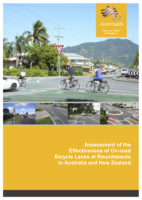Road Design

- Publication no: AP-R461-14
- ISBN: 978-1-925037-68-5
- Published: 16 May 2014
- PDF (free) Download
This report documents the research undertaken for Austroads on bicycle lanes at roundabouts. An extensive literature review informed empirical data gathering.The literature review revealed strong evidence that bicycle lanes on the approach and within roundabouts are associated with negative safety outcomes. Limited and inconclusive research was found on high-speed, multi-lane roundabouts. The dominant cyclist injury crash type involved a motorist entering a roundabout failing to give way to a circulating cyclist. Cyclists could maximise their safety by tracking closer towards the inscribed island.
Cyclist lateral tracking was observed at urban roundabouts, which showed that they commonly travelled close to the centre of the traffic lane. Where bicycle lanes were present in the circulating carriageway, they were rarely used by riders. When lane markings were changed at roundabouts to encourage lane sharing, this significantly shifted cyclist positions. It was concluded that the presence of bicycle lanes within the roundabout may serve to discourage lane sharing. High-speed, multi-lane roundabouts were not studied due to the unacceptable risk the researchers would have been exposed to.
Motorist approach speeds across a range of single lane and multi-lane roundabouts were measured and found to be surprisingly similar. Within 20 m of the holding line, horizontal and vertical deflection, or limited visibility to the right could be used to reduce vehicle speeds to an equitable speed of desirably 25 km/h (maximum 30 km/h); this would provide greater time for motorists to scan for conflicting movements (including cyclists) and to reduce the severity of any crash that may occur. This additional time would be likely to reduce the most frequent conflict between motorists and cyclists.
A key conclusion from the research is that new or modified roundabouts would ideally either have equitable speeds, or provide for cyclists so that they don’t have to enter the circulating carriageway. The tangential roundabout design philosophy of English-speaking countries maximises capacity, whilst the radial design philosophy of continental European countries maximises safety of all users. Other useful geometric elements are vertical deflection, horizontal deflection, and tighter approach radii.
Strong evidence was found that lane markings that encourage cyclists to “claim the lane” (for example sharrows) can be effective and are recommended where speeds are equitable. Cycle lanes on the approach should terminate some distance behind the holding line where speeds are low. Where equitable speeds are achieved, approach lanes should not exceed 3.0 m in width so that drivers do not attempt to enter the roundabout alongside cyclists.
Where equitable speeds are unachievable, consideration should be given to physical separation on the approach and departure. The report authors cannot provide conclusive guidance on circulatory cycle lanes due to a lack of data and more research is required.
All the evidence is pointing towards speed being the major road safety issue at roundabouts. If the underlying fundamental problem is addressed, then the question that this research is supposed to answer (will bicycle lanes at roundabouts improve safety?) will become secondary. Our research shows conclusively that cyclists maximise their safety when they occupy a lane, and this is most easily achieved when speeds are equitable.
- 1. Introduction
- 1.1. Problem
- 1.2. Research study purpose
- 1.3. Scope
- 1.4. Overall study method
- 2. Literature review
- 2.1. Review aims
- 2.2. Context
- 2.2.1. Geometry
- 2.2.2. Superelevation
- 2.2.3. Types of roundabouts
- 2.2.4. Provisions for cycling in roundabouts
- 2.2.5. Crash types and conflict points
- 2.3. Research review
- 2.3.1. Large urban roundabout research – Schnüll et al
- 2.3.2. Radial single lane research – Schoon and van Minnen
- 2.3.3. Small roundabouts – Haller and Brilon
- 2.3.4. Swiss single lane roundabouts – Spacek
- 2.3.5. Belgian research – Daniels et al
- 2.3.6. U.S. lane positioning and conflict study – TRB
- 2.3.7. Canadian injury study – Winters
- 2.3.8. Australian literature review – Patterson
- 2.3.9. Literature review and Victorian crash analysis – Cumming
- 2.3.10. Literature review and Queensland crash analysis – McDonald
- 2.3.11. Danish research on motorist observation of cyclists – Lund
- 2.3.12. Visibility and crash prediction models – New Zealand research
- 2.3.13. C-roundabouts – New Zealand research
- 2.3.14. Crash data – Australasian research
- 2.4. Design guidance
- 2.4.1. Australia and New Zealand
- 2.4.2. United States
- 2.4.3. Ireland
- 2.4.4. United Kingdom
- 2.4.5. Germany
- 2.4.6. Netherlands
- 2.4.7. Denmark
- 2.5. Literature summary
- 3. Crash analysis
- 3.1. Aim
- 3.2. Aggregate crash data
- 3.2.1. Crash analysis system (New Zealand)
- 3.2.2. Victorian data
- 4. Fieldwork method
- 4.1. Key variables
- 4.2. Measures of effectiveness
- 4.3. Data collection methods
- 4.4. Site selection
- 5. Fieldwork Results
- 5.1. Lateral tracking
- 5.1.1. Canning Street and Pigdon Street, Melbourne
- 5.1.2. Mason Street, Melbourne
- 5.1.3. Macrae Road, Perth
- 5.1.4. Gold Coast
- 5.2. Speed measurements
- 6. Discussion
- 6.1. Introduction
- 6.2. Bicycle lanes in roundabouts and at other locations
- 6.3. Road rules
- 6.4. Lateral cyclist tracking
- 6.5. Equitable speeds
- 6.6. Bicycle storage boxes and bicycle symbols
- 6.7. High-speed roundabouts
- 7. Key Findings and Recommendations
- 7.1. Key findings
- 7.2. Research recommendations
- Appendix A Research Questions
- Appendix B Speed Profiles
